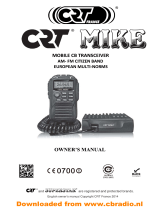1918
CB 10-CODES
Citizens Band radio operators have largely adopted the “10-code” for
standard questions and answers. Its use permits faster communications
and better understanding in noisy areas. The following table lists some
of the more common codes and their meanings:
Code Meaning Code Meaning
10-1 Receiving poorly
10-2 Receiving well
10-3 Stop transmitting
10-4 OK, message received
10-5 Relay message
10-6 Busy, stand by
10-7 Out of service, leaving air
10-8 In service, subject to call
10-9 Repeat message
10-10 Transmission completed,
standing by
10-11 Talking too rapidly
10-12 Visitors present
10-13 Advise Weather/Road
conditions
10-16 Make pick up at
10-17 Urgent business
10-18 Anything for us?
10-19 Nothing for you, return to base
10-20 My location is
10-21 Call by telephone
10-22 Report in person to
10-23 Stand by
10-24 Completed last assignment
10-25 Can you contact
10-26 Disregard last information
10-27 I am moving to channel
10-28 Identify your station
10-29 Time is up for contact
10-30 Does not conform to FCC rules
10-32 I will give you a radio check
10-33 EMERGENCY TRAFFIC
10-34 Trouble at this station
10-35 Confidential information
10-36 Correct time is
10-37 Wrecker needed at
10-38 Ambulance needed at
10-39 Your message delivered
10-41 Please turn to channel
10-42 Traffic accident at
10-43 Traffic Tie up at
10-44 I have a message for you
10-45 All units within range
please report
10-50 Break channel
10-60 What is next
message number?
10-62 Unable to copy,
use phone
10-63 Net directed to
10-64 Net clear
10-65 Awaiting your next
message/assignment
10-67 All units comply
10-70 Fire at
10-71
Proceed with transmission
in sequence
10-77 Negative contact
10-81 Reserve hotel room for
10-82 Reserve room for
10-84 My telephone number is
10-85 My address is
10-91 Talk closer to mike
10-93 Check my frequency on
this channel
10-94 Please give me a
long count
10-99 Mission completed, all
units secure
10-200 Police needed at
Operating Procedure for Emergency Communications
1.
For EMERGENCY communications, set radio to Ch. 9. For non-
emergency communications, select desired Channel by rotating the
CHANNEL UP/DOWN tuning knob until reaching the desired Channel.
Be sure the antenna is properly connected to the radio before transmit-
ting. Prolonged transmitting without an antenna, or use of a poorly
matched antenna, could cause damage to the transmitter.
2. When asking for aid on Channel 9 it is suggested that you request a
REACT base to respond by saying "Break Channel 9 for a REACT base"
and provide the CB DISTRESS DATA (called "CLIP):
CALL SIGN-Identify yourself and vehicle.
LOCATION-Be exact.
INJURIES-Number. Type. Trapped?
PROBLEM- Give details and help required. Air CLIP repeatedly so any
monitor can aid you.
If you don't receive a response on Ch. 9; try Ch.14 or 19.
USE CHANNEL 9 FOR EMERGENCY ONLY
FCC gives the following examples of permitted and prohibited types of
communications for use on Channel 9. These are guidelines and are not
intended to be all-inclusive.
Permitted Example Message
Yes "A tornado sighted six miles north of town."
No "This is observation post number 10. No tornado sighted."
Yes "I am out of gas on Interstate 95 at mile marker 121."
No "I am out of gas in my driveway."
Yes "There is a four-car collision at Exit 10 on the Beltway,
send police and ambulance."
No "Traffic is moving smoothly on the Beltway."
Yes "Base to Unit 1, the Weather Bureau has just issued a
thunderstorm warning. Bring the sailboat into port."
No "Attention all motorists. The Weather Bureau advises that
the snow tomorrow will accumulate 4 to 6 inches."
Yes "There is a fire in the building on the corner of 6th and
Main Streets."
No "This is Halloween patrol unit number 3. Everything is
quiet here."
45WX.MANUAL.9/97.qx 9/26/97 2:39 PM Page 19













